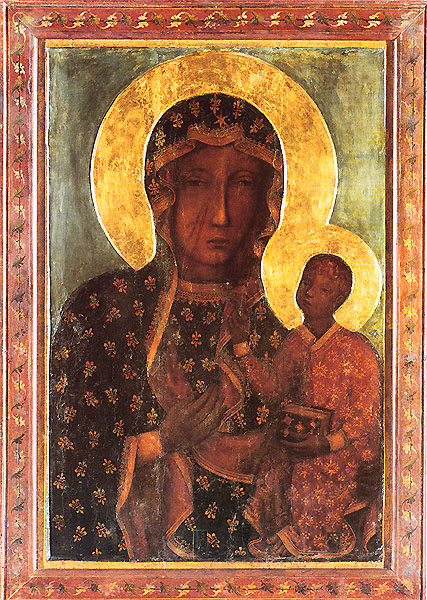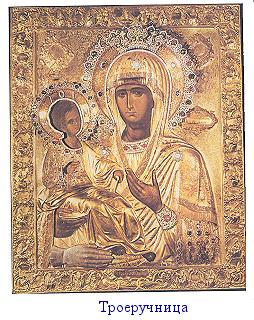Mother of God of the Sign, Czestochowa and Damascus
Our Lady of Czestochowa is an icon of St. Luke brought to Constantinople by
St. Helena which eventually ended up in Poland with Catholic King Ladislaus.
The image was damaged by a Tartar arrow (on the neck) and in 1430 by the
Protestant Hussite heretics who cut the icon in three pieces and left two sword slashes on the
Virgin's cheek The slashes defied efforts to cover when the icon was repaired.
The icon, called 'black' because of the smudge of oil lamps over the years,
is credited with saving 300 Polish Catholic defenders from 12,000 Prostant Swedish invaders in 1655
leading to Catholic King Casimir crowning the icon the 'Queen of Poland'. It later preserved Polish freedom
from and Russian communists in 1920.

The Theotokos of Damascus
originated in 717 when the iconoclast Byzantine Emperor Leo the Isaurian tricked
the Moslem Calif of Damascus into believing that St. John Damascene was a traitor.
The calif had St. John's hand cut off but after a night of prayer to the Virgin Mary, it was miraculously rejoined to his arm.
In thanksgiving, St. John
commissioned a special silver representation of his hand that was attached
to the icon covering (lower left). The original icon is now in the Hilander monastery on Mt. Athos.

Mother of God of the Sign (Shirshaya)
is based on the orans/prayer drawings of the catacombs, and was painted in the 12th century by
iconographer St. Alipy of the Kiev Caves. When the city of Novgorod was beseiged by an
army from Kiev, Bishop St. John had the icon placed on the city walls where it was struck
by an arrow.
Tears came from the eyes of the Virgin: the 'sign' of her intervention. A cloud immediately
covered the attacking army who turned on themselves in confusion and were routed by the
defenders from Novgorod.
Many similar icons have
protected other Russian cities notably Kursk where it was discovered in the late 13th century
by a hunter. The Kursk icon miraculously rejoined itself after being cut in
two by a Tartar swordsman and provided protection for the city many times thereafter.



|